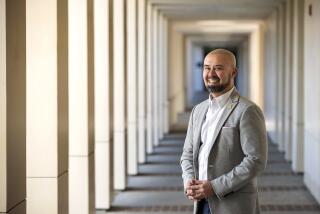Central County : Rancho Santiago Seeks Low-Income Latinos
- Share via
Despite recent gains, Rancho Santiago College still needs to increase its enrollment of Latino students from low-income families, members of the board of trustees said Monday.
The trustees discussed Latino enrollment after receiving a report on the community colleges’ participation in a state-funded program designed to increase college attendance by low-income persons, called the Extended Opportunity Programs and Services (EOPS).
Last year, Rancho Santiago had 39 Latino students in the EOPS program, according to John West, dean of student services. He predicted the number would increase to 100 this fall. But some trustees said they are still unhappy with the small number of Latino students getting the special state aid. “Our district is right in the middle of a huge minority population--actually, in Santa Ana, it’s the majority population,” said Rodolfo Montejano, one of the seven trustees of the district, which includes Santa Ana, Orange and a portion of Garden Grove. “I think we have a responsibility to do something about this. This is a very important issue with the board.
West, in an interview after his appearance before the board, said the state’s “very low income requirements” are the main reason Rancho Santiago is unable to place more Latino students. To be eligible for the program, the state says total income cannot exceed $11,099 for a family of four. “With a low income like that, many families can’t afford to have a child go to college. They’re more interested in getting bread for the table,” West said.
He pointed out that the state program reimburses the school only for tuition and support services, while the student gets no stipend.
West said Rancho Santiago has a fairly large Latino enrollment--about 3,000 of its 20,000 students on all its campuses last year--but he said almost all of those are ineligible for the state program.
In other business, the board approved a $41.8-million budget for the 1985-86 school year, a increase of $4.2 million over last year.
More to Read
Sign up for Essential California
The most important California stories and recommendations in your inbox every morning.
You may occasionally receive promotional content from the Los Angeles Times.













